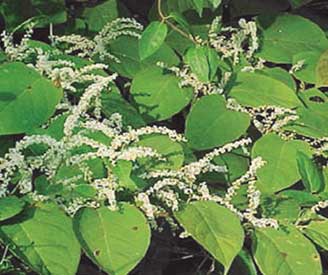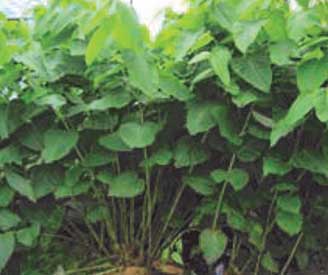Japanese & Giant Knotweed
Fallopia japonica, F. sachalinensis
Description
These species are listed as state noxious weeds. They were introduced to the United Sates from England in the 1800’s to be used as ornamental plants. They can grow to over 10 feet tall. All of these knotweed species have stems that are reddish-brown, stout, cane-like and hollow between the nodes and have spade (or heart-) shaped leaves. Japanese knotweed have leaves that are about 6 inches long by 4 inches wide attached alternately to a zigzag branch. Bohemian knotweed have larger leaves than Japanese knotweed that are profusely branched in a zig zag pattern. The leaves of the giant knotweed are 6-12 inches long and two-thirds as wide. These knotweeds are often found in disturbed areas, neglected gardens, along roadsides, riverbanks and stream-banks and other moist areas in fields.
Habitat
Often found in disturbed areas, neglected gardens, along roadsides, riverbanks and stream-banks and other moist areas in fields.
Location in Nebraska
Japanese knotweed is found in a few counties in Southeast Nebraska. The other species are not widespread in the state.
Pathway of Introduction and Spread
The Japanese, bohemian and giant knotweed were introduced to the United Sates from England in the 1800’s to be used as ornamental plants. Small segments of the plant are able to regenerate into new plants and are commonly transported by water and regenerate new plants on the banks of streams. These plant segments may be transported to new sites by foot traffic, equipment, mowing and improper disposal of vegetation. Also produces viable seed. Has escaped landscapes.
Impacts
Threatens open and riparian areas where it spreads rapidly and forms dense, near monoculture stands by reducing species diversity, altering habitat for wildlife, increasing the risk of flooding and river bank erosion.
Prevention
The knotweeds can be managed through mechanical, and chemical control methods. The first step in any of these management methods is prevention. This includes planting crops free of saltcedar seeds, preventing the movement of infested hay, and cleaning farm, recreation and personal wear equipment being used in multiple fields or wetlands. Mechanical management includes pulling of entire root system or cutting the stems about 2 inches above ground level in the early spring. Chemical control methods are effective when applied in early spring to stunt the plants. Contact your local County Weed Control Authority for chemical control recommendations. The most effective treatment method again is a mix of those above and persistence.

